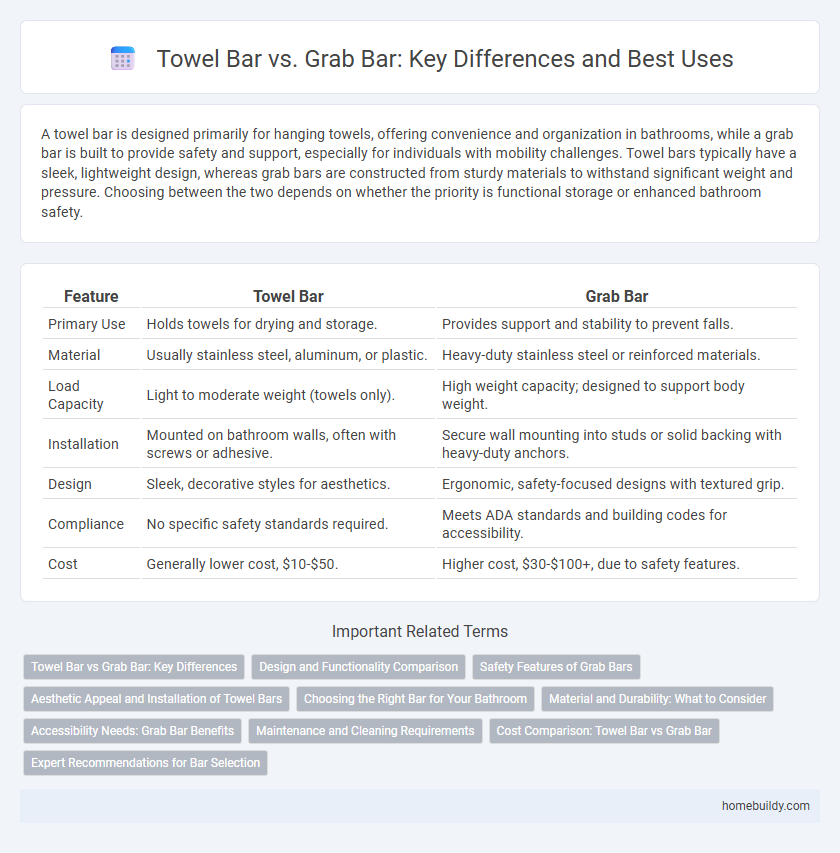A towel bar is designed primarily for hanging towels, offering convenience and organization in bathrooms, while a grab bar is built to provide safety and support, especially for individuals with mobility challenges. Towel bars typically have a sleek, lightweight design, whereas grab bars are constructed from sturdy materials to withstand significant weight and pressure. Choosing between the two depends on whether the priority is functional storage or enhanced bathroom safety.
Table of Comparison
| Feature | Towel Bar | Grab Bar |
|---|---|---|
| Primary Use | Holds towels for drying and storage. | Provides support and stability to prevent falls. |
| Material | Usually stainless steel, aluminum, or plastic. | Heavy-duty stainless steel or reinforced materials. |
| Load Capacity | Light to moderate weight (towels only). | High weight capacity; designed to support body weight. |
| Installation | Mounted on bathroom walls, often with screws or adhesive. | Secure wall mounting into studs or solid backing with heavy-duty anchors. |
| Design | Sleek, decorative styles for aesthetics. | Ergonomic, safety-focused designs with textured grip. |
| Compliance | No specific safety standards required. | Meets ADA standards and building codes for accessibility. |
| Cost | Generally lower cost, $10-$50. | Higher cost, $30-$100+, due to safety features. |
Towel Bar vs Grab Bar: Key Differences
Towel bars and grab bars serve distinct purposes in bathroom design, with towel bars primarily used for hanging towels and grab bars providing safety support for users. Grab bars are built with sturdy, slip-resistant materials and anchored securely to withstand weight, while towel bars focus on style and convenience without the structural reinforcements needed for safety. Understanding these functional and structural differences is crucial when selecting the right fixture for bathroom usability and safety compliance.
Design and Functionality Comparison
Towel bars are designed primarily for holding towels and feature a sleek, lightweight build that complements bathroom aesthetics, while grab bars emphasize safety with sturdy, textured surfaces and reinforced mounting for support. Towel bars prioritize aesthetic appeal and ease of access to towels, whereas grab bars focus on providing stability and preventing slips with their ergonomic design and weight-bearing capabilities. The functionality of grab bars exceeds that of towel bars in terms of safety, though towel bars offer more versatility in decorative bathroom setups.
Safety Features of Grab Bars
Grab bars are specifically designed with enhanced safety features such as textured, non-slip surfaces and secure wall anchoring to support significant weight, reducing the risk of falls in wet areas. Unlike towel bars, which are primarily for holding towels and often lack the structural integrity for support, grab bars meet strict building codes and standards for accessibility and safety. Their ergonomic design ensures a firm grip, making them essential for individuals with limited mobility or balance issues in bathrooms.
Aesthetic Appeal and Installation of Towel Bars
Towel bars offer a sleek and minimalist aesthetic that complements modern bathroom designs, unlike grab bars which prioritize functionality over style. Installation of towel bars is typically straightforward, requiring only basic tools and standard wall anchors, making them accessible for DIY projects. Their discreet presence enhances bathroom decor without compromising space or visual harmony.
Choosing the Right Bar for Your Bathroom
When selecting between a towel bar and a grab bar for your bathroom, prioritize safety or functionality based on your needs. Towel bars primarily serve as convenient storage for towels, adding aesthetic appeal and organization. Grab bars, constructed with sturdy materials like stainless steel and installed near showers or toilets, provide essential support and prevent slips, making them crucial for accessibility and elderly users.
Material and Durability: What to Consider
Towel bars are typically made from materials such as stainless steel, chrome, or aluminum, offering moderate durability suited for lightweight use. Grab bars, constructed from heavy-duty stainless steel or reinforced materials, prioritize strength and corrosion resistance to support substantial weight and ensure user safety. When choosing between the two, consider the material's thickness, coating, and mounting hardware to balance aesthetic appeal with long-term durability and reliability.
Accessibility Needs: Grab Bar Benefits
Grab bars provide superior support and stability compared to towel bars, making them essential for accessibility in bathrooms. They are designed to assist individuals with mobility challenges, reducing the risk of slips and falls by offering a secure handhold. Unlike towel bars, grab bars are built to withstand significant weight and pressure, ensuring safety for elderly or disabled users.
Maintenance and Cleaning Requirements
Towel bars require minimal maintenance, typically involving regular dusting and wiping with a mild detergent to prevent water spots and soap scum buildup. Grab bars, designed for safety, demand more frequent inspection and cleaning with disinfectants to eliminate bacteria and ensure secure mounting hardware remains intact. Both fixtures benefit from routine checks, but grab bars necessitate stricter hygiene and maintenance protocols due to their critical role in fall prevention.
Cost Comparison: Towel Bar vs Grab Bar
Towel bars generally cost between $10 and $50, making them a budget-friendly option for bathroom accessory needs, while grab bars range from $40 to $150 due to their enhanced safety features and sturdier construction. Installation costs for grab bars tend to be higher as they require secure mounting to support weight, often involving professional labor, whereas towel bars can typically be installed with minimal tools and effort. The price gap reflects the functional differences, with grab bars providing critical support and meeting safety regulations compared to the primarily decorative and convenience-focused towel bars.
Expert Recommendations for Bar Selection
Experts recommend selecting towel bars primarily for hanging lightweight textiles and maintaining bathroom aesthetics, while grab bars should be chosen for safety and support, especially in wet areas to prevent falls. Towel bars typically lack the weight capacity and sturdy mounting requirements essential for grab bars, which must comply with safety standards like ADA guidelines. Proper installation following manufacturer instructions ensures durability and functionality, with grab bars requiring reinforced wall anchors to support significant user weight.
Towel bar vs Grab bar Infographic

 homebuildy.com
homebuildy.com